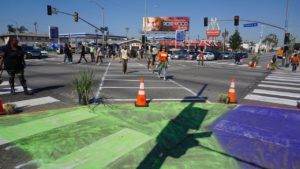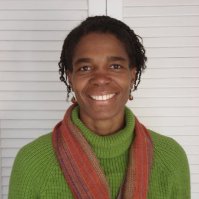By Danyelle O’Hara, Special to the Funders’ Network
Few cities in the U.S. are as defined by their urban streetscapes as Los Angeles: About 15 percent of land in the City of Angels is taken up by roadways, meaning the city has more streets than anywhere else in America.
In 2014, L.A. Mayor Eric Garcetti announced the first 15 streets that would benefit from the city’s Great Streets Initiative, intended to improve neighborhood gathering places and revitalize key community corridors.
“The Great Streets Initiative is about strengthening neighborhoods one ‘main street’ at a time,” said Garcetti when the initiative was originally announced.
To accomplish this, the city established the Great Streets Studio, comprised of dedicated staff with an office in City Hall tasked with community outreach and project development — and created with the support of a Partners for Places matching grant.
The Great Streets Studio team became the central coordinating entity for infrastructure planning and development, bringing together the efforts underway as part of the L.A. Housing Departments transit-oriented Consolidated Plan, the Department of City Planning’s Mobility and Health Elements, the Department of Transportation’s Great Streets Strategic Plan, and the L.A. County Metropolitan Transportation Authority’s (Metro) massive build-out of a fixed-guideway transit system.

The genesis of its work stretches back to 2011, when the Los Angeles planning commission created the Transportation Corridor Cabinet to consider how to better coordinate around land use, transportation, equity and health issues historically siloed.
The Transportation Corridor Cabinet in turn formed an advisory committee composed of the Metropolitan Transportation Authority’s board of directors, the president of city planning, advisors from community nonprofits and from The California Endowment and the California Community Foundation. Through the various perspectives represented on the committee, a set of strategies was developed to link transportation, land use, and the needs of L.A. communities.
This work was underway at the time of the mayoral transition in LA, so The California Endowment and the California Community Foundation, with support from other funders in Los Angeles, joined with the City’s Office of Sustainability to pursue a Partners for Places grant in 2013 to sustain the Transportation Corridor Cabinet’s work across political administrations.
Los Angeles received a $50,000 grant from Partners for Places, matched by funding from the California Community Foundation and The California Endowment, making a total of $150,000 available to support equitable transit-oriented planning. The funds supported the Great Streets Studio team to coordinate Mayor Garcetti’s Great Streets Initiative.
Ann Sewill, vice president of Health and Housing at the California Community Foundation, said the funding helped ensure that those efforts to connect transportation to issues of equity and health continued. “We saw this grant as a way to highlight this work as a good thing for the new administration, a way to keep the momentum going and deepen it,” she said.
Garcetti, who won the 2013 mayoral election, had highlighted the linkages between transportation, streets, and neighborhoods in his campaign, so it was not surprising when he made Great Streets Studio his first executive directive upon taking office. (Garcetti won reelection in 2017.)
Great Streets Studio has a vision for a transit-oriented Los Angeles that is accessible, affordable, and centered on neighborhoods with great streets as their backbone. To move this vision into action, Great Streets built a system for collaboration, communication, and accountability within city agencies and with community stakeholders. Visioning work started early on by asking L.A. residents how they viewed community access to city programs and resources. This process clarified that many residents shared a perception of city work as “siloed,” with little coordination and communication about resources and investments on community streets. Understanding these perceptions enabled city agencies and departments to develop systems to deliver programs and resources with increased transparency and better alignment with community needs and expectations.
The Green Streets Studio has three major goals:
Empowering: Making L.A. streets the centerpieces of L.A. communities means providing communities with the tools to lead in developing visions for their streets.
Connecting: To implement the changes that communities seek, Great Streets studios connects residents, businesses and organizations to each other and to the tools the city provides, from infrastructure to public art grants, and everything in between.
Developing: When existing city programs or policies can’t meet the needs of Great Streets communities, Great Streets Studio works with colleagues in city government to design and implement new programs.

Photo Credit: Hector Felix Photography
In 2016, the city announced seven winners of the Great Streets Challenge, a program investing $2 million in community-driven initiatives to re-imagine Los Angeles’ iconic commercial corridors. The seven winning projects span from Panorama City to Watts, and from the Westside to Boyle Heights.
As Garcetti says in his message to residents on the Great Streets website: “By reimagining our streetscape, we can create transformative gathering places for Angelenos to come together, whether they travel by car, transit, bike or on foot.”
|
About the author:
Since 1990, Danyelle O’Hara has worked with a range of organizations in the United States and internationally to help build capacity in issues related to community economic development, natural resources management, and community change. In West and Central Africa, Danyelle worked with Catholic Relief Services and the World Wildlife Fund and in the U.S., she has worked as staff to the Center for Community Self-Help and The Conservation Fund, and with numerous organizations as a consultant. Danyelle has a Bachelor’s degree in anthropology and a Master’s in international development education, both from Stanford University, and extensive experience in program development and design, program management, and evaluation.
About Partners for Places: A collaborative matching grant program, Partners for Places creates opportunities for cities and counties in the United States and Canada to improve communities by building partnerships between local government sustainability offices and place-based foundations. Partners for Places is led by TFN and our partners at the Urban Sustainability Directors Network. National funders invest in local projects to promote a healthy environment, a strong economy, and well-being of all residents. Through these projects, Partners for Places fosters long-term relationships that make our urban areas more prosperous, livable, and vibrant. To date, Partners for Places has awarded more than $5 million across North America in this successful matching grant program, leading to more than $10 million in investments.
|

 Danyelle O’Hara, Consultant for the Funders’ Network
Danyelle O’Hara, Consultant for the Funders’ Network